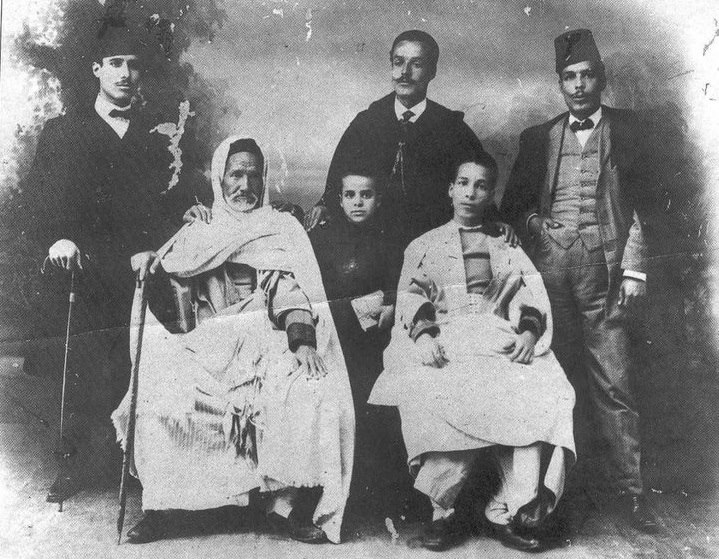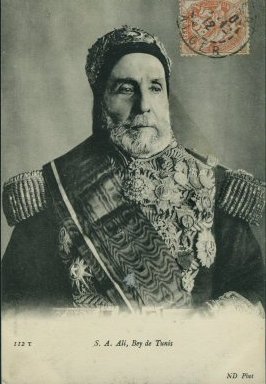|
King Of Tunisia
The beys of Tunis were the monarchs of Tunisia from 1705, when the Husainid dynasty acceded to the throne, until 1957, when monarchy was abolished. History The Husainid dynasty, originally of Cretan Turkish origin, came to power under Al-Husayn I ibn Ali on July 15, 1705, replacing the Muradid dynasty. For most of their rule, the Husainids ruled with the title of Bey. The Husainids ruled the Beylik of Tunis under the suzerainty of the Ottoman Empire until May 12, 1881, when Muhammad III as-Sadiq signed the Treaty of Bardo and the Beylik of Tunis came under the control of France as a protectorate. Following independence from France on March 20, 1956, the Kingdom of Tunisia was proclaimed and the Bey Muhammad VIII al-Amin assumed the title of King. He reigned as such until the Prime Minister Habib Bourguiba deposed the Husainid dynasty and declared Tunisia a one-party republic on July 25, 1957, ruling as President for life until he was deposed in 1987. Beys of Tunis (1705� ... [...More Info...] [...Related Items...] OR: [Wikipedia] [Google] [Baidu] |
Al-Husayn I Ibn Ali
Al-Husayn I ibn Ali, also known as Hussein I ( ar, حسين الأول; born in 1675 – 13 September 1740). He was the founder of the Husainid Dynasty, which ruled Tunisia until the abolition of the monarchy in 1957. Biography Husayn was born a Kouloughli, which is a term used to refer to an Ottoman father and a local North African mother. His father was a Turkish and his mother was a Tunisian. The Husaynids were called " Turkish" by Habib Bourguiba and, until recently, discussion of their origins was taboo. In 1702 the commander |
Habib Bourguiba
Habib Bourguiba (; ar, الحبيب بورقيبة, al-Ḥabīb Būrqībah; 3 August 19036 April 2000) was a Tunisian lawyer, nationalist leader and statesman who led the country from 1956 to 1957 as the prime minister of the Kingdom of Tunisia (1956–57) then as the first president of Tunisia (1957–87). Prior to his presidency, he led the nation to independence from France, ending the 75-year-old protectorate and earning the title of "Supreme Combatant". Born in Monastir to a poor family, he attended Sadiki College then Lycée Carnot in Tunis, before obtaining his baccalaureate in 1924. He graduated from the University of Paris and the Paris Institute of Political Studies (Sciences Po) in 1927 and returned to Tunis to practice law. In the early 1930s, he became involved in anti-colonial and Tunisian national politics, joining the Destour party and co-founding the Neo Destour in 1934. He rose as a key figure of the independence movement and was repeatedly arrested ... [...More Info...] [...Related Items...] OR: [Wikipedia] [Google] [Baidu] |
Ali III Ibn Al-Husayn
Ali Bey ( ar, أبو الحسن علي باشا باي بن الحسين) (14 August 1817 – 11 June 1902) was the Husainid Bey of Tunis from 1882 until his death. He was the first ruler under the French protectorate. He was named Bey al-Mahalla (Heir Apparent) on 23 August 1863 by his brother Muhammad III as-Sadiq and was made a divisional General and placed at the head of an army column operating in the interior of the country (known in Tunisian Arabic as the ''mhalla'') to assert beylical authority in remote regions, rendering justice in the name of the sovereign and collecting taxes from local tribes. A keen horseman, Ali Bey took personal charge of this work and undertook it thoroughly, twice a year - in the north of the country during the summer in Béja and El Kef, and in the south during the winter, in Kairouan and the towns further south. During the Mejba Revolt in 1864, while his ineffective brother remained in the Bardo palace, Ali put down the rebellion with Gene ... [...More Info...] [...Related Items...] OR: [Wikipedia] [Google] [Baidu] |
Muhammad II Ibn Al-Husayn
Mohammed Bey ( ar, أبو عبد اله محمد باشا باي) or M'hamed Bey (18 September 1811 – 22 September 1859)Ibn Abi Dhiaf, ''op. cit.'', p. 293 was the eleventh Husainid Bey of Tunis, ruling from 1855 until his death. He was the son of Al-Husayn II ibn Mahmud and his second wife Lalla Fatima al-Munastiri. As Bey al-Mahalla (Heir Apparent) he had been awarded the rank of divisional general in the Ottoman army in August 1840, and was raised to the rank of marshal on 7 August 1855, shortly after he succeeded his cousin Ahmad Bey on 30 May 1855. He retained his predecessor's key minister Mustapha Khaznadar as Grand vizier and surrounded himself with competent ministers such as Kheireddine Pacha and Generals Hussain and Rustum as well as devoted counsellors including Mohamed Bayram IV, Mahmoud Kabadou and Ismaïl Caïd Essebsi. After his accession he proceeded with reforms, including, on 10 September 1857, the Fundamental Pact which recognised religious freedom an ... [...More Info...] [...Related Items...] OR: [Wikipedia] [Google] [Baidu] |
Ahmad I Ibn Mustafa
Ahmed I ( ar, أبو العباس أحمد باشا باي), born 2 December 1805 in TunisIbn Abi Dhiaf, ''Présent des hommes de notre temps. Chroniques des rois de Tunis et du pacte fondamental'', vol. IV, éd. Maison tunisienne de l'édition, Tunis, 1990, p. 12 died 30 May 1855 at La Goulette,Ibn Abi Dhiaf, ''op. cit.'', p. 184 was the tenth Husainid Bey of Tunis, ruling from 1837 until his death. He was responsible for the abolition of slavery in Tunisia in 1846. He succeeded his father Mustafa Bey on 10 October 1837. He had grand ambitions - to expand his army and create a modern navy; to build a new royal residence, a mint and modern institutions of education but neither he nor his brother-in-law the young Mustapha Khaznadar who served as his finance minister, had a clear idea of what such initiatives would cost. As a result, many of his projects became expensive failures which damaged the financial health of the country. Ottoman Recognition Soon after his accession, ... [...More Info...] [...Related Items...] OR: [Wikipedia] [Google] [Baidu] |
Mustafa Ibn Mahmud
Mustafa ibn Mahmud (1786–1837) ( ar, مصطفى باي بن محمد) was the ninth leader of the Husainid Dynasty The Husainid dynasty or Husaynid dynasty ( ar, الحسينيون) was a ruling dynasty of the Beylik of Tunis, which was of Greek origin from the island of Crete. It came to power under al-Husayn I ibn Ali in 1705, succeeding the Muradid dynast ... and the ruler of Tunisia from 1835 until his death in 1837. References 1786 births 1837 deaths Beys of Tunis Tunisian royalty {{Tunisia-politician-stub ... [...More Info...] [...Related Items...] OR: [Wikipedia] [Google] [Baidu] |
Al-Husayn II Ibn Mahmud
Al-Husayn II ibn Mahmud (; 5 March 1784 – 20 May 1835) was the Bey of Tunis from 1824 until his death in 1835. He was of a Greek Greek may refer to: Greece Anything of, from, or related to Greece, a country in Southern Europe: *Greeks, an ethnic group. *Greek language, a branch of the Indo-European language family. **Proto-Greek language, the assumed last common ancestor ... descent royal family. See also * Hussein Khodja References 1835 deaths 1784 births Tunisian people of Turkish descent Tunisian royalty Flag designers {{Tunisia-politician-stub ... [...More Info...] [...Related Items...] OR: [Wikipedia] [Google] [Baidu] |
Mahmud Ibn Muhammad
Mahmud ibn Muhammad (10 July 1757 – 28 March 1824) ( ar, أبو الثناء محمود باشا باي) was the seventh leader of the Husainid Dynasty The Husainid dynasty or Husaynid dynasty ( ar, الحسينيون) was a ruling dynasty of the Beylik of Tunis, which was of Greek origin from the island of Crete. It came to power under al-Husayn I ibn Ali in 1705, succeeding the Muradid dynast ... and the ruler of Tunisia from 1814 until his death in 1824. See also * Hussein Khodja References 1757 births 1824 deaths Beys of Tunis Tunisian royalty {{Tunisia-politician-stub ... [...More Info...] [...Related Items...] OR: [Wikipedia] [Google] [Baidu] |
Hammuda Ibn Ali
Abu Mohammed Hammuda ibn Ali Pasha (9 December 1759 – 15 September 1814) ( ar, أبو محمد حمودة ابن علي باشا) was the fifth leader of the Husainid dynasty and the ruler of Tunisia from 26 May 1782 until his death on 15 September 1814. See also *Moustapha Khodja *Venetian bombardments of the Beylik of Tunis (1784–88) *Youssef Saheb Ettabaa Youssef Saheb Ettabaa ( ar, يوسف صاحب الطابع; born c. 1765, died 23 January 1815), was a Tunisian politician and a mameluk of Moldavian origin. He became a Prime Minister of the Beylik of Tunis. Early career He was enslaved as a ... References 18th-century people from the Ottoman Empire 19th-century people from the Ottoman Empire 18th-century Tunisian people 19th-century Tunisian people 1759 births 1814 deaths Beys of Tunis 18th-century rulers in Africa 19th-century rulers in Africa Tunisian royalty {{Tunisia-politician-stub ... [...More Info...] [...Related Items...] OR: [Wikipedia] [Google] [Baidu] |
Ali II Ibn Hussein
Ali II ibn Hussein (24 November 1712 – 26 May 1782) ( ar, أبو الحسن علي باي) was the fourth leader of the Husainid Dynasty and the ruler of Tunisia from 1759 until his death in 1782. See also *Moustapha Khodja *Muhammad al-Warghi *Rejeb Khaznadar Rejeb Khaznadar ( ar, رجب خزندار; died May 21, 1797 in Tunis) was a Tunisian politician and before that he was a mamluk of Greek origin. He became Prime Minister of the Beylik of Tunis in 1759, becoming the first Prime Minister in the his ... {{DEFAULTSORT:Ali 2 Ibn Hussein 18th-century people from the Ottoman Empire 18th-century Tunisian people 1712 births 1782 deaths Beys of Tunis 18th-century rulers in Africa Tunisian royalty ... [...More Info...] [...Related Items...] OR: [Wikipedia] [Google] [Baidu] |
Muhammad I Ar-Rashid
Muhammad I ar-Rashid ( ar, أبو عبد الله محمد الرشيد باي; 1710 – 12 February 1759) was the third leader of the Husainid Dynasty and the ruler of Tunisia from 1756 until his death. See also *Rejeb Khaznadar Rejeb Khaznadar ( ar, رجب خزندار; died May 21, 1797 in Tunis) was a Tunisian politician and before that he was a mamluk of Greek origin. He became Prime Minister of the Beylik of Tunis in 1759, becoming the first Prime Minister in the his ... {{DEFAULTSORT:Muhammad 1 Ar-Rashid 18th-century people from the Ottoman Empire 18th-century Tunisian people 1710 births 1759 deaths Beys of Tunis 18th-century rulers in Africa Tunisian royalty ... [...More Info...] [...Related Items...] OR: [Wikipedia] [Google] [Baidu] |



